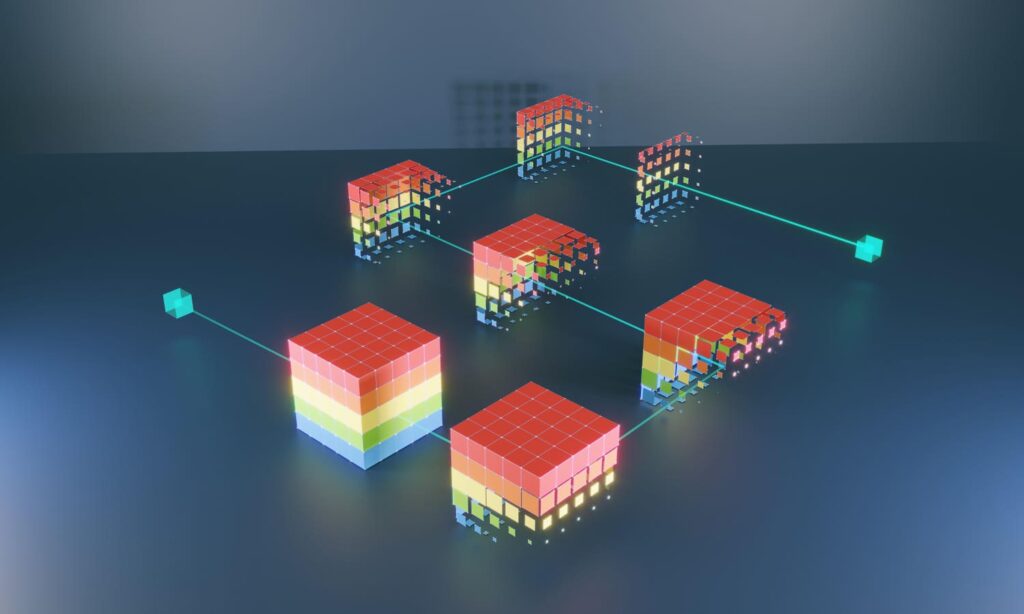The race to remake global finance is heating up, and the starting gun has already fired on Wall Street. While traditional banks grapple with systems that trap trillions in idle capital, a new financial architecture is emerging from the fusion of blockchain technology and traditional finance (TradFi). The prize isn’t just eliminating the friction that costs the industry billions in settlement delays and reconciliation headaches—it’s fundamentally rewiring how money moves. Early movers aren’t just experimenting anymore; they’re driving the financial blockchain market toward a projected $49.2 billion by 2030, up from $2.1 billion in 2023.
The shift isn’t just theoretical. At Davos 2025, Bank of America CEO Brian Moynihan likened crypto to established payment systems: “If you go down the street here and buy lunch, you could pay with Visa, Mastercard, a debit card, Apple Pay, and so on. In that sense, cryptocurrency would just be another form of payment.”
Behind the glass towers of Wall Street, this future is already materializing. The DTCC’s Project Ion, leveraging distributed ledger technology, is rewiring financial infrastructure’s fundamental plumbing by shifting from batch to real-time processing and creating a single, unified transaction record—slashing reconciliation costs and delivering significant savings. Already handling over 100,000 bilateral equity transactions daily, with peaks reaching 160,000 trades, Project Ion operates within today’s T+2 settlement framework while blazing the trail toward T+1 and potentially T+0 settlement—a shift that could unlock billions in capital currently trapped in settlement limbo. Banking giants BNY Mellon, Citi, and JP Morgan aren’t just watching from the sidelines—they’re already all in.
Cross-border payments remain the industry’s biggest bottleneck—slow, costly, and reliant on an outdated patchwork of intermediaries. Trillions move across borders every year, yet transactions can take days, saddled with 4%+ fees and opaque banking rails. Enter stablecoins—by converting fiat into digital tokens on global blockchain networks, banks unlock 24/7, near-instant money movement at scale. This innovation lets institutions bypass correspondent banking friction entirely, settling transactions in minutes rather than days. JPMorgan Coin already processes $1 billion in daily settlements, and the broader market for tokenized dollars is on track to hit $400 billion by 2025. The economic case is striking: where traditional transfers trap money for days and drain substantial fees, blockchain-powered stablecoins deliver instant settlement at a fraction of the cost. This shift has tech giants like Microsoft and Amazon building Blockchain-as-a-Service (BaaS) platforms, accelerating enterprise blockchain adoption.
The transformation spans every corner of finance. Deutsche Bank, HSBC, and Standard Chartered have launched blockchain initiatives to streamline operations, while payment giants Visa and Mastercard are integrating the technology into their global networks. Asset management leaders Fidelity, BlackRock, Goldman Sachs, and JPMorgan are pushing into real-world assets (RWA), recognizing blockchain’s potential to transform asset tokenization and settlement. Franklin Templeton’s expansion of its money market fund across Solana, Ethereum, Stellar, and other major blockchain networks signals a new phase—traditional asset managers are no longer experimenting; they’re building multi-chain infrastructure for the future.
The New Financial Order
Three key forces are accelerating blockchain’s adoption in TradFi: First, legacy banking systems struggle to meet real-time global demands; second, regulatory clarity around digital assets is improving; third, institutional investors—once skeptical—are now integrating blockchain solutions to bridge traditional and digital finance. Unlike early blockchain disruptors who sought to replace traditional finance, today’s players are bridging legacy systems with digital innovation—prioritizing functionality over disruption.
The road ahead presents a delicate balancing act. As banks and financial institutions embrace blockchain, they must navigate the fine line between pushing innovation forward and staying within regulatory bounds. Enterprise solutions like R3 Corda are emerging as crucial bridges, offering the institutional-grade infrastructure needed for this transition. At the same time, decentralized networks are evolving to put compliance first—pointing toward a future where innovation and regulation coexist in harmony.
Among new solutions, Chainlink, Aave, and Compound are pioneering DeFi infrastructure, while Graphite Network is bridging TradFi and DeFi, offering verification and compliance-focused solutions that major institutions can trust. A reputation-based Layer 1 blockchain, it integrates privacy-preserving KYC (ZKPs), institutional compliance, and high-speed transactions (1,400 TPS at low fees). Each account has a behavior-based reputation score, protecting users from untrustworthy members. Verified single-user accounts and Proof-of-Authority Polymer 2.0 deliver compliant, scalable blockchain solutions for large projects.
The Transaction Speed Challenge: Can Blockchain Match Traditional Finance?
However, institutional players face a fundamental challenge: aligning blockchain’s transformative promise with TradFi’s relentless demand for speed and reliability. As titans like Nasdaq, CME Group, and ICE explore blockchain integration, they confront a staggering benchmark—traditional financial networks routinely process upwards of 65,000 transactions per second during peak times, a volume that would overwhelm most blockchain systems. While Layer 2 solutions such as Optimism, Arbitrum, and Polygon have delivered incremental speed boosts and reduced costs, these fixes simply can’t scale to meet the colossal throughput and near-instant finality demanded by modern institutional finance.
This staggering performance pressure has sparked a new wave of foundational innovation. Rather than merely patching existing systems, emerging Layer 1 solutions are reengineering the blockchain’s very core to tackle scalability and efficiency at an enterprise level. Among these, DevvE integrates enterprise compliance frameworks with Web2 functionality through RESTful APIs. Backed by global patents and a non-custodial instant settlement exchange, DevvE enables real-world asset tokenization with excellent scalability and lightning-fast L1 transaction speeds. Will Stewart, a veteran in global finance, recently joined DevvDigital’s Board to drive institutional adoption, reinforcing DevvE’s position as a key player in financial evolution.
With scalability solutions maturing, attention has shifted to perhaps the most transformative application of blockchain in traditional finance: asset tokenization.
The Tokenization Frontier: From Concept to Execution
Tokenization of real-world assets (RWAs) is blockchain’s most promising institutional use case. Morgan Stanley, Credit Suisse, and UBS are exploring tokenization, while JP Morgan and Goldman Sachs have already run controlled pilots testing digital representations of bonds and private equity. Early security token pioneers like Polymath and Harbor proved feasibility but lacked mass adoption. Today, platforms like Securitize, tZERO, and Templum have taken the lead, effectively bridging traditional finance with blockchain.
As tokenization gains traction, AI-driven compliance is emerging as a competitive edge. Rexas Finance is leveraging this approach, allowing users to tokenize a wide range of assets, from real estate to intellectual property, while ensuring automated compliance and global trading capabilities. With $45M+ raised and 47,000+ holders, Rexas provides a secure, scalable infrastructure that streamlines asset management for both institutional and retail investors. Seamless multi-chain integration enables fast, secure, and cost-effective transactions, making asset tokenization more accessible.
Moving forward, successful platforms will be those that balance blockchain’s limitless potential with institutional finance’s practical requirements. With DeFi platforms projected to reach a $100 billion valuation, the transformation isn’t theoretical—it’s happening now.
Conclusion: The Road Ahead
While blockchain promises to revolutionize finance, its journey is fraught with significant risks. The $165 million ASX blockchain upgrade failure in 2022 starkly reminds us that even the most well-funded projects can stumble. But it’s not just about failed implementations – the stakes are exponentially higher when it comes to security. Picture a smart contract flaw that could instantly freeze millions in assets or a private key breach that makes traditional password hacks look like child’s play. This is why financial giants aren’t rushing headlong into the blockchain future. Instead, they’re adopting what insiders call a “walk-before-run” strategy: JPMorgan and Goldman Sachs maintain their battle-tested legacy systems alongside blockchain pilots, while BNY Mellon is investing heavily in blockchain forensics. Their message is clear: in the race to transform finance, security isn’t just another checkbox – it’s the foundation upon which everything else builds.
Global financial institutions are already committing billions to blockchain integration. The next phase will bring standardization, deeper integration, and hybrid financial models that blend traditional and blockchain infrastructure. By accelerating settlement speeds and eliminating inefficiencies, blockchain isn’t just upgrading financial systems—it’s fundamentally reimagining them for the digital age.
Read the full article here















